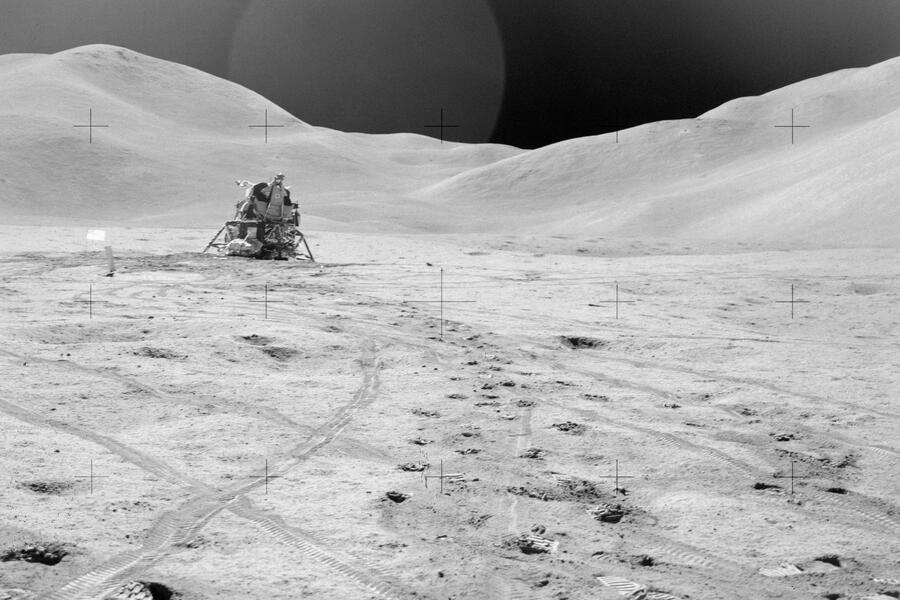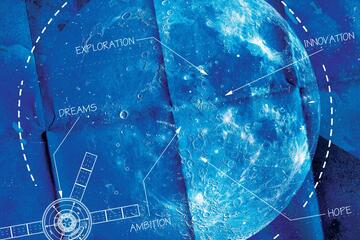When spacecraft land on the moon, their engines unleash huge clouds of dust and debris that can damage expensive equipment and threaten future lunar bases. As space agencies plan to establish a lasting presence on the moon, understanding how these plumes form has become a critical priority.
A research team led by Rui Ni, associate professor of mechanical engineering at Johns Hopkins University's Whiting School of Engineering, is helping to answer that by investigating the complex interaction between rocket exhaust and the lunar surface. Since 2021, in collaboration with NASA's Marshall Space Flight Center and the University of Michigan, Ni's team has focused on a puzzling phenomenon—the regularly spaced dust streaks radiating from the touchdown point—a pattern first observed during the Apollo era and seen again during the recent landing of Firefly Aerospace's Blue Ghost lander.
Key Takeaways
- Scientists discovered that distinctive dust streaks during moon landings are caused by rotating vortices from curved rocket exhaust.
- High-speed lunar dust can damage critical equipment during moon landings.
- This research could help engineers design safer landing strategies for future lunar missions.
That distinctive pattern has never been fully explained—until now. Ni's team, whose findings appear in Nature Communications, uncovered the fluid dynamics behind this phenomenon and revealed how the moon's vacuum environment amplifies the behavior of dust particles during descent.
"We set out to understand the unusual patterns observed during lunar landings and discovered that these distinctive patterns are the result of the Görtler instability, a fluid dynamics phenomenon where the curved flow of exhaust gases over the moon's surface creates forces that generate rotating vortices, leading to the characteristic patterns we see in the dust clouds," Ni said. "More broadly, we're exploring how particles are eroded and mobilized during extraterrestrial landings."
Understanding this dust ejecta is more than a scientific curiosity—it's a practical necessity. High-speed lunar dust can behave like a sandblasting jet, potentially damaging landers, habitats, solar panels, and other infrastructure critical to a lunar outpost. Ni's research offers essential insights for engineering safer landings and protecting future missions from the very surface they're aiming to explore.
To do this, the team mounted a six-camera system in the Marshall Space Flight Center's 15-foot vacuum chamber to study the erosion caused by a gas jet running above a bed of simulated lunar soil. Using this setup, they captured crater formation and tracked the trajectory and velocity of the small soil particles. By utilizing the Lunar soil simulant in a near-vacuum environment, the team provided a dataset that is the first of its kind and relevant to future missions to the moon.
"We discovered that the strikingly regular streak patterns seen during landings aren't caused by the chosen landing sites," Ni said. "Instead, they result from the behavior of the supersonic rocket plume as it imprints on the granular surface. This effect is extremely pronounced on the moon due to its near-vacuum environment."
Although humans have not returned to the moon in more than 50 years, space science has continued to benefit from Apollo-era knowledge, but as new crewed missions approach, the gaps in that knowledge are becoming crucial to fill. Ni said that understanding the dust plume issue is particularly critical for future Artemis missions, where permanent structures like a lunar outpost are part of the plan.
"Our work helps identify the risks, offers ways to mitigate the risks, and improves predictions of erosion rates during landings," he said. "Our findings pave the way for future missions to optimize landing strategies and mitigate dust cloud effects on equipment and visibility."
Team members from Johns Hopkins University included PhD students Miguel X. Diaz-Lopez and Matthew Gorman.
Posted in Science+Technology
Tagged fluid dynamics









